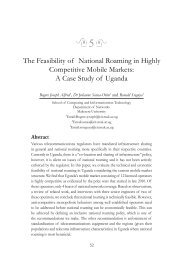Undergraduate Handbook - School of Computing and Informatics ...
Undergraduate Handbook - School of Computing and Informatics ...
Undergraduate Handbook - School of Computing and Informatics ...
Create successful ePaper yourself
Turn your PDF publications into a flip-book with our unique Google optimized e-Paper software.
vii. M. Mirabito, B. Morgenstern, Communication Technology <strong>and</strong> Social Change: Theory <strong>and</strong> Implications<br />
Lea's Communication Series, Lawrence Erlbaum, 2006.<br />
BSE 1103: System Analysis <strong>and</strong> Design (3 CU)<br />
Course Description: This course introduces established <strong>and</strong> evolving methodologies for the analysis <strong>and</strong> design <strong>of</strong><br />
an information system. Great emphasis is placed on system characteristics, managing projects, prototyping,<br />
CASE/OOM tools, systems development life cycle phases, the role <strong>of</strong> the systems analyst, systems selection,<br />
definition <strong>of</strong> systems requirements, feasibility analysis, system design, <strong>and</strong> system architecture are topics included.<br />
Upon completion, students should be able to analyze a problem <strong>and</strong> design an appropriate solution using a<br />
combination <strong>of</strong> tools <strong>and</strong> techniques.<br />
Indicative Content:<br />
• SAD Fundamentals: Introduction to IS & types <strong>of</strong> IS; Need for SAD & role <strong>of</strong> Analyst; SDLC & use <strong>of</strong><br />
CASE tools; Determining feasibility & mgt <strong>of</strong> SAD activities.<br />
• Information Requirements Analysis Information gathering (Interactive methods, unobtrusive methods,<br />
RAD, prototyping); Determining Systems requirements (types <strong>of</strong> requirements)<br />
• The Analysis Process: Structuring systems requirements (describing process specifications & structured<br />
decisions) Data modelling; Process modelling; Preparing System proposals.<br />
• The Design Process: Designing effective output; Designing effective input (Accurate Data entry<br />
Procedures); User Interface design; Database Design.<br />
• System Implementation: Quality Assurance through S<strong>of</strong>tware Engineering (design with structured charts,<br />
testing, maintenance, auditing, Quality mgt); Implementing Information Systems (user training, conversion<br />
strategies, systems evaluation<br />
• Project Management: Stages <strong>of</strong> system Development; Project planning; Estimation & Project Monitoring &<br />
Control<br />
• Introduction to Object-oriented Systems Analysis & Design using UML<br />
Reference Books:<br />
i. Kendall & Kendall, Systems Analysis <strong>and</strong> Design, 6th edition, Pearson Prentice Hall, 2005.<br />
ii. J. A. H<strong>of</strong>fer, J. F. George <strong>and</strong> J. S. Valacich , Modern Systems Analysis <strong>and</strong> Design, 2nd edition, Addison-<br />
Wesley, 1999.<br />
BSE 1104: Discrete Mathematics (3 CU)<br />
Course Description: Upon successful completion <strong>of</strong> this course, the student will: Be familiar with the terminology,<br />
operations, <strong>and</strong> symbols <strong>of</strong> set theory, <strong>and</strong> with formal logic; Be able to use logic to determine the validity <strong>of</strong> an<br />
argument; Be able to construct the pro<strong>of</strong> <strong>of</strong> a theorem directly, by the contra positive, by cases, by contradiction, by<br />
truth table, by counter-example, <strong>and</strong> by mathematical induction; Be able to identify a relation; specifically, a partial<br />
order, equivalence relation, or total order; Be able to identify a function; specifically, subjective, injective, <strong>and</strong><br />
objective functions; Be able to perform operations on matrices; Be familiar with the terminology for graphs <strong>and</strong><br />
trees; Be able to trace Euler <strong>and</strong> Hamiltonian paths; Be able to construct minimal spanning trees <strong>and</strong> adjacency<br />
matrices for graphs; Have begun to develop a logical mode <strong>of</strong> thought that will be applicable to computer design,<br />
both hardware <strong>and</strong> s<strong>of</strong>tware.; Be able to underst<strong>and</strong> sequential logic; Be able to underst<strong>and</strong> sets <strong>and</strong> relations <strong>and</strong> be<br />
able to represent information using zeros <strong>and</strong> ones.<br />
Indicative Content: Set algebra, logic, relations <strong>and</strong> functions, recursion, matrices; graph theory, <strong>and</strong> methods <strong>of</strong><br />
pro<strong>of</strong>. Emphasis is on an algorithmic approach; Set theory; Methods <strong>of</strong> pro<strong>of</strong>; Recursion; Matrix algebra; Graphs<br />
<strong>and</strong> trees. Application to data structure <strong>and</strong> graph representations, partial ordered sets, trees, algebraic structures,<br />
lattices <strong>and</strong> Boolean algebra, semi groups, groups, introduction to grammars <strong>and</strong> machines <strong>and</strong> languages, error<br />
correcting codes; Representation <strong>of</strong> information two’s complement arithmetic. Combinational logic: switching<br />
106

















